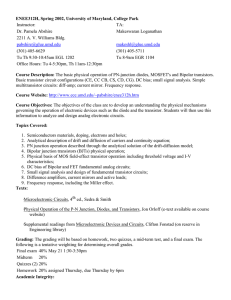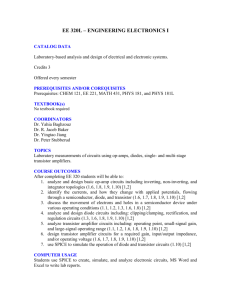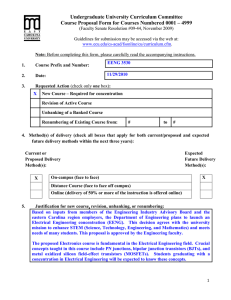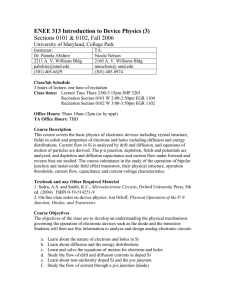Semiconductor Devices and Analog Electronics (3) University of Maryland, College Park
advertisement
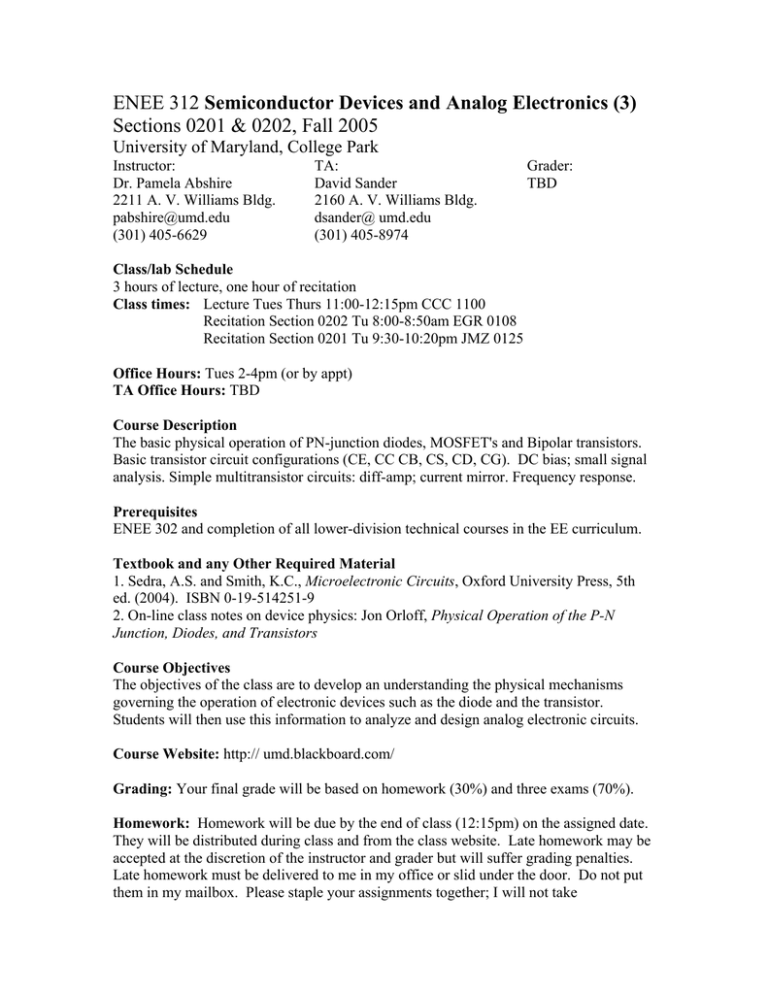
ENEE 312 Semiconductor Devices and Analog Electronics (3) Sections 0201 & 0202, Fall 2005 University of Maryland, College Park Instructor: Dr. Pamela Abshire 2211 A. V. Williams Bldg. pabshire@umd.edu (301) 405-6629 TA: David Sander 2160 A. V. Williams Bldg. dsander@ umd.edu (301) 405-8974 Grader: TBD Class/lab Schedule 3 hours of lecture, one hour of recitation Class times: Lecture Tues Thurs 11:00-12:15pm CCC 1100 Recitation Section 0202 Tu 8:00-8:50am EGR 0108 Recitation Section 0201 Tu 9:30-10:20pm JMZ 0125 Office Hours: Tues 2-4pm (or by appt) TA Office Hours: TBD Course Description The basic physical operation of PN-junction diodes, MOSFET's and Bipolar transistors. Basic transistor circuit configurations (CE, CC CB, CS, CD, CG). DC bias; small signal analysis. Simple multitransistor circuits: diff-amp; current mirror. Frequency response. Prerequisites ENEE 302 and completion of all lower-division technical courses in the EE curriculum. Textbook and any Other Required Material 1. Sedra, A.S. and Smith, K.C., Microelectronic Circuits, Oxford University Press, 5th ed. (2004). ISBN 0-19-514251-9 2. On-line class notes on device physics: Jon Orloff, Physical Operation of the P-N Junction, Diodes, and Transistors Course Objectives The objectives of the class are to develop an understanding the physical mechanisms governing the operation of electronic devices such as the diode and the transistor. Students will then use this information to analyze and design analog electronic circuits. Course Website: http:// umd.blackboard.com/ Grading: Your final grade will be based on homework (30%) and three exams (70%). Homework: Homework will be due by the end of class (12:15pm) on the assigned date. They will be distributed during class and from the class website. Late homework may be accepted at the discretion of the instructor and grader but will suffer grading penalties. Late homework must be delivered to me in my office or slid under the door. Do not put them in my mailbox. Please staple your assignments together; I will not take responsibility for lost sheets. If you go by another name than the one officially registered with the University, please write both names down for the first few assignments. While I encourage you to discuss course material with other students, the homework problems are to be completed independently. If your homework appears to be identical to another student's, you may be asked to demonstrate your understanding of the material to the instructor or TA in an oral quiz. Homework solutions that are not legible will not be graded. Exams and Quizzes: Your final score will be based in part on two equally-weighted midterm exams and one larger final exam. The dates for the exams will be announced in class at least one week in advance. Makeup exams are only possible for those with officially documented excuses (i.e. approved by the undergraduate studies office). Exam questions will be based on the material covered in class. All work for long answer questions must be shown in order to receive full credit. Office Hours: Please come during regular office hours (Tues 2-4pm). Other times are fine, but by appointment ONLY. Questions about the homework, grading, or the material presented in class should be first directed to the TA or grader. Recitation Sections: The TA will review material, solve example problems, and answer questions about class material and homework during the recitation sections. Some supplementary class material may also be given during the recitations. Course Materials Distribution: While much of the course material will be distributed in the class lecture, supplementary course material will be available from the class website and via direct email to students in the class. In the beginning of the course, I will attempt to verify that class notifications are reaching your email address, however, it will be your responsibility to ensure continued receipt of class information. All class announcements will be posted onto the class website as an alternative means of retrieving updated information. Absences: It is my intent to respect our diverse community's religious observances, so please inform me in writing (email) of any intended absences for religious observances in advance. Notice should be provided as soon as possible but no later than the end of the second week of classes. Academic Integrity: Although I am not expecting to encounter this issue, I would like to make it very clear that academic dishonesty will not be tolerated. All work submitted for grading must be your own. The University of Maryland’s Code of Academic Integrity, which can be found at http://www.studenthonorcouncil.umd.edu/code.html, prohibits students from committing the following acts of academic dishonesty: cheating, fabrication, facilitating academic dishonesty, and plagiarism. Academic dishonesty in this class includes outright copying of homework or deliberately taking unfair advantage of other students in the class; however, discussing homework problems is permissible and also encouraged. Instances of academic dishonesty will be referred to the Honor Council. In this course, we will be covering the following topics: Semiconductors materials, doping, electrons, holes, drift-diffusion; Basic physical operation of P-N junction diodes; Basic physical operation of bipolar junction transistors; Basic physical operation of MOSFETs; Basic transistor circuit configurations (CE, CC, CB, CS, CD, CG); DC bias and small signal operation of fundamental transistor circuits; Multiple transistor circuits, differential amplifiers, current mirrors; Active loads and op-amps; Frequency response; Simulation, Design, and Fabrication Techniques** While we will not be discussing it in class, it is expected that you are familiar with the program PSPICE and are able to use it to enhance your understanding of the various circuits to be presented in class. Some of the supplementary material on the web site may be in PSPICE form. ** For students interested in designing and fabricating integrated circuits, extra credit modules are available. The programs PSPICE and LASI can be used for integrated circuit simulation and design, and students may submit successful designs to the MOSIS service for fabrication of integrated circuits. Tentative Schedule (subject to change): Week 1 (Sep 1): introduction and review Week 2 (Sep 6, 8): electronic materials, doping, carrier motion Week 3 (Sep 13, 15): quasistatic diffusion equation, P-N junction qualitative Week 4 (Sep 20, 22): P-N junction quantitative, diode bias and small signal model Week 5 (Sep 27, 29): diode circuits Week 6 (Oct 4, 6): Exam #1, BJT intro, forward mode Week 7 (Oct 11, 13): BJT reverse mode, PNP, Ebers-Moll Model, DC bias Week 8 (Oct 18, 20): BJT small signal operation, single transistor amps CE/CB/CC Week 9 (Oct 25, 27): MOSFET physical operation, DC bias Week 10 (Nov 1, 3): MOSFET small signal operation, single transistor amps CS/CG/CD Week 11 (Nov 8, 10): Exam #2, multiple transistor circuits (current mirrors) Week 12 (Nov 15, 17): differential pairs, differential amplifiers, active loads Week 13 (Nov 22): frequency response, Thanksgiving holiday Nov 24-25 Week 14 (Nov 29, Dec 1): amplifier frequency response CS/CE, CG/CB Week 15 (Dec 6, 8): frequency response cont’d. source degeneration, followers Week 16 (Dec 13): frequency response cont’d. differential amplifier, multistage amplifier Final Exam: TBD. Tentatively Thurs Dec 15 8-10 am. Possible change to Thurs Dec 15 1:30-3:30pm. Contribution of the Course to Meet the Professional Component One and one-half years of engineering topics, to include engineering sciences and engineering design appropriate to the student's field of study Relationship of Course to Program Objectives (a) an ability to apply knowledge of mathematics, science, and engineering: SIGNIFICANT − Students learn to apply mathematics to understand the operation of devices and circuits and they apply this knowledge of elementary electrical principles such as Kirchoff's laws to analyze electrical circuits containing active elements. (c) an ability to design a system, component, or process to meet desired needs: SOME − The students are required to develop a beginning ability to design simple circuit components. (e) an ability to identify, formulate, and solve engineering problems: SIGNIFICANT − The students are expected to be able to solve elementary engineering problems by learning to identify a goal and to use standard engineering tools such as SPICE or mathematical methods to solve the problem by designing a circuit to meet certain specifications. (j) a knowledge of contemporary issues: MODEST − The frontiers of device and circuit performance such as minimum dimensions and maximum speed will be discussed. (k) an ability to use the techniques, skills, and modern engineering tools necessary for engineering practice: SIGNIFICANT − The students are taught how to solve problems involving elementary analog electronics using the basic tools from earlier courses, as well as more advanced techniques.
